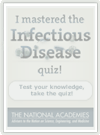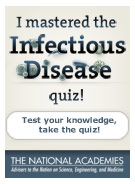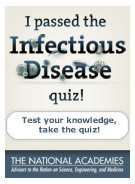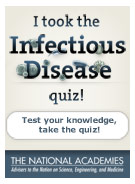
What You Need To Know About Infectious Disease
What do you know about infectious disease?
Which deadly pathogen cannot be found naturally in the wild:
-
Sorry, that’s incorrect.
Smallpox cannot be found naturally in the wild. Smallpox was officially declared eradicated from the globe in 1980, after an 11-year WHO vaccination campaign—the first human disease to be eliminated as a naturally spread contagion. Today, the virus remains only in laboratory stockpiles.
-
Sorry, that’s incorrect.
Smallpox cannot be found naturally in the wild. Smallpox was officially declared eradicated from the globe in 1980, after an 11-year WHO vaccination campaign—the first human disease to be eliminated as a naturally spread contagion. Today, the virus remains only in laboratory stockpiles.
-
Correct!
Smallpox cannot be found naturally in the wild. Smallpox was officially declared eradicated from the globe in 1980, after an 11-year WHO vaccination campaign—the first human disease to be eliminated as a naturally spread contagion. Today, the virus remains only in laboratory stockpiles.
True or False: Thimerosal, a mercury-containing preservative that was used in some vaccines and other products, has been shown to present a risk to human health.
-
Sorry, that’s incorrect.
The use of thimerosal has been an object of controversy, with some arguing that the substance caused autism in children. However, extensive independent research has presented no convincing evidence of harm associated with the low levels of thimerosal previously present in vaccines.
-
Correct!
The use of thimerosal has been an object of controversy, with some arguing that the substance caused autism in children. However, extensive independent research has presented no convincing evidence of harm associated with the low levels of thimerosal previously present in vaccines.
Which of the following is NOT a type of infectious agent?
-
Sorry, that’s incorrect.
White blood cells are not a type of infectious agent. Part of the immune system, white blood cells fight infection rather than cause it.
-
Sorry, that’s incorrect.
White blood cells are not a type of infectious agent. Part of the immune system, white blood cells fight infection rather than cause it.
-
Correct!
White blood cells are not a type of infectious agent. Part of the immune system, white blood cells fight infection rather than cause it.
-
Sorry, that’s incorrect.
White blood cells are not a type of infectious agent. Part of the immune system, white blood cells fight infection rather than cause it.
Since the beginning of the 20th century, the number of people in the world has:
-
Sorry, that’s incorrect.
Since the beginning of the 20th century the number of people in the world has more than quadrupled—from 1.6 billion to nearly 7 billion—and world population is expected to rise to well over 9 billion by 2050.
-
Sorry, that’s incorrect.
Since the beginning of the 20th century the number of people in the world has more than quadrupled—from 1.6 billion to nearly 7 billion—and world population is expected to rise to well over 9 billion by 2050.
-
Correct!
Since the beginning of the 20th century the number of people in the world has more than quadrupled—from 1.6 billion to nearly 7 billion—and world population is expected to rise to well over 9 billion by 2050.
Public health officials can identify the outbreak of disease by monitoring certain patterns of behavior through syndromic surveillance. Which of the following is one of the signs used to identify a disease outbreak using this system?
- Level of school and work absenteeism
- Sales of over-the-counter medication
- Number of illness-related 911 calls
- All of the above
-
Sorry, that’s incorrect.
In syndromic surveillance, all of the above are used in addition to other patterns that suggest an outbreak. Despite the emergence of this innovative surveillance method, most surveillance still depends on tracking reported infections.
-
Sorry, that’s incorrect.
In syndromic surveillance, all of the above are used in addition to other patterns that suggest an outbreak. Despite the emergence of this innovative surveillance method, most surveillance still depends on tracking reported infections.
-
Sorry, that’s incorrect.
In syndromic surveillance, all of the above are used in addition to other patterns that suggest an outbreak. Despite the emergence of this innovative surveillance method, most surveillance still depends on tracking reported infections.
-
Correct!
In syndromic surveillance, all of the above are used in addition to other patterns that suggest an outbreak. Despite the emergence of this innovative surveillance method, most surveillance still depends on tracking reported infections.
Which reproduce the fastest:
-
Sorry, that’s incorrect.
Viruses reproduce the fastest. Humans produce a new generation every 20 years or so; bacteria do it every 20 to 30 minutes, and viruses even faster.
-
Sorry, that’s incorrect.
Viruses reproduce the fastest. Humans produce a new generation every 20 years or so; bacteria do it every 20 to 30 minutes, and viruses even faster.
-
Correct!
Viruses reproduce the fastest. Humans produce a new generation every 20 years or so; bacteria do it every 20 to 30 minutes, and viruses even faster.
If you have strep throat, which of the following forms of medication can be used to effectively treat the infection?
-
Sorry, that’s incorrect.
Because strep throat is caused by a bacterium called Streptococcus pyogenes, it is treatable with antibiotics but not antivirals. Currently there is no vaccine available to prevent strep throat.
-
Correct!
Because strep throat is caused by a bacterium called Streptococcus pyogenes, it is treatable with antibiotics but not antivirals. Currently there is no vaccine available to prevent strep throat.
-
Sorry, that’s incorrect.
Because strep throat is caused by a bacterium called Streptococcus pyogenes, it is treatable with antibiotics but not antivirals. Currently there is no vaccine available to prevent strep throat.
-
Sorry, that’s incorrect.
Because strep throat is caused by a bacterium called Streptococcus pyogenes, it is treatable with antibiotics but not antivirals. Currently there is no vaccine available to prevent strep throat.
Which of the following is not a viral disease:
-
Sorry, that’s incorrect.
Trichinosis is not a viral disease. It is caused by a helminth (parasitic worm) found in undercooked meat, not by a virus.
-
Sorry, that’s incorrect.
Trichinosis is not a viral disease. It is caused by a helminth (parasitic worm) found in undercooked meat, not by a virus.
-
Correct!
Trichinosis is not a viral disease. It is caused by a helminth (parasitic worm) found in undercooked meat, not by a virus.
Of the more than 1,700 known viruses, bacteria, and other pathogens that infect people, how many have come from animals?
-
Sorry, that’s incorrect.
More than half of the known pathogens that infect people have come from animals. Of the 37 new infectious diseases identified in just the past 30 years, two-thirds sprang from animals.
-
Sorry, that’s incorrect.
More than half of the known pathogens that infect people have come from animals. Of the 37 new infectious diseases identified in just the past 30 years, two-thirds sprang from animals.
-
Correct!
More than half of the known pathogens that infect people have come from animals. Of the 37 new infectious diseases identified in just the past 30 years, two-thirds sprang from animals.
Thank you for taking our quiz.
Place this badge on your Facebook page to show your friends what you know about infectious disease.
Place this badge on your Facebook page to show your friends what you know about infectious disease.
OR, get a higher score to unlock a different badge.

Place this badge on your Facebook page to show your friends what you know about infectious disease.
OR, get a higher score to unlock a different badge.

Explore Other Topics
Disease Watchlist
Infectious Disease Defined
- RNA
Short for ribonucleic acid, RNA is a molecule with long strands of nucleic acids containing a nitrogenous base, a ribose sugar, and a phosphate. RNA is responsible for controlling a number of chemical activities, including protein synthesis, within cells.


